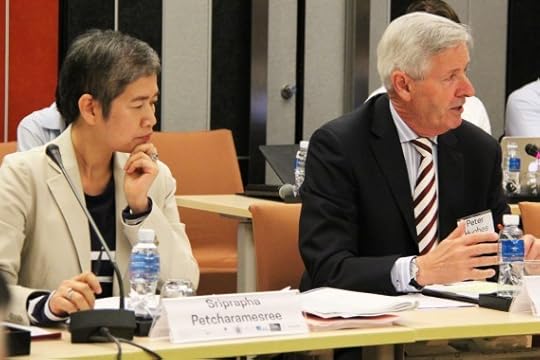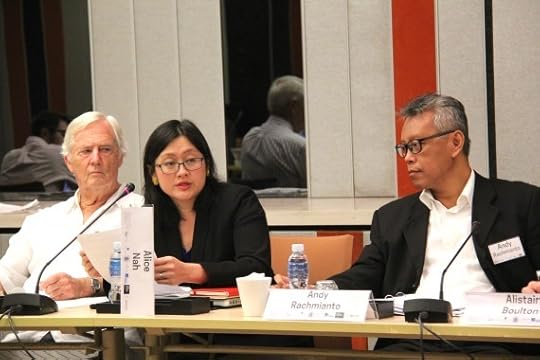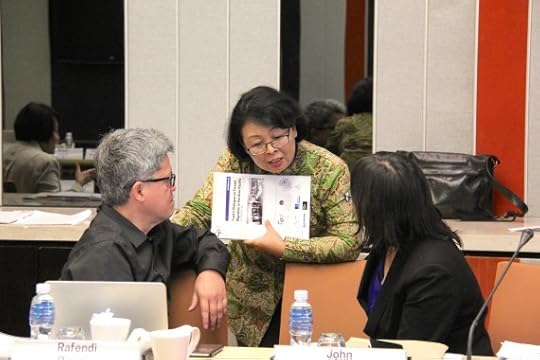Centre for Policy Development's Blog, page 40
March 1, 2016
Democracy and disillusionment in a digital era
Above: CPD hosts Simon Willis from Change.org at roundtables in Sydney and Melbourne, with generous support from BCG and ANU House Melbourne.
In February 2016 CPD participated in a number of discussions on democratic renewal in a digital era.
On the 19 and 23 February, CPD in partnership with ANU and Boston Consulting Group hosted Simon Willis from Change.org at two roundtables as part of our Effective Government Program. Simon is Managing Director of the organisation’s operations in Europe and Australia and has extensive experience in and outside the British Government including as Head of Financial Crime at Her Majesty’s Treasury and as Private Secretary to the Minister for Work and Pensions. He joined Change.org in 2015 from the Young Foundation. He is now one the world’s leading experts on digital democratic platforms.
Change.org has evolved from a Californian start-up organisation to a major global online platform for petitioning and awareness raising. The site now has approximately 140 million users worldwide. In Australia, one in seven Australians has signed a petition on Change.org, and a petition is successful in our country once every 24 hours. Even sitting state and federal MPs start petitions on issues of local importance to their constituents.
CPD’s roundtables in Sydney and Melbourne were attended by key experts and influencers from government, start-ups and not-for-profit organisations.
In his opening remarks, Simon argued that it was a fascinating time for digital platforms because there is a crisis about how well democratic institutions serve the interests of the community. He said there has been an erosion in the trust and confidence people place in civic and political institutions. Simon also argued that the internet has begun disrupting and transforming political engagement and empowerment but that the transformation is far from over.
Attendees were invited to discuss the role and impact of digital platforms like Change.org on not just political debate but also policy development and decision making. Participants in both cities also had robust discussions on how such platforms allow the public sector itself to collaborate more effectively with the community in influencing policy and achieving social ends.
One of the more robust elements of the discussion regarded the need for online petition platforms like Change.org to have greater linkages and cross-community collaboration in order to sustain causes and coalitions beyond a single petition, in order to generate holistic change. This includes utilising the community’s experience, skills and diversity to increase legitimacy and credibility. Unquestionably these lines of enquiry will remain at the forefront of democratic renewal for a long time. CPD looks forward to continuing our work on these themes in 2016 and beyond.
On 17 February in Melbourne, Travers McLeod participated in a panel discussion entitled After Russell Brand – Making democracy work better for you. Trav was joined by Maria Katsonis (Policy Director, Victorian Department of Premier and Cabinet), Nicholas Reece (Public Policy Fellow, University of Melbourne) and Samah Hadid (Human Rights Campaigner). Chaired by Dr Leslie Cannold (Ethicist and public educator), the panel discussed how citizens can have greater and more meaningful power in policy decisions made by government, and how the public sector can better engage the community in deliberative policy discussions that go beyond typical submissions and consultation processes. Panelists examined the dire state of party memberships around Australia, the volatile and unpredictable nature of our politics as well as the rise of digital democratic platforms. They boldly attempted to forecast how our politics might change in the years ahead, including in ways yet unimagined.
If you are interested to attend the next event in the Melbourne Conversation series, you can find more information here.

The post Democracy and disillusionment in a digital era appeared first on CPD.
February 10, 2016
Second meeting of the Asia Dialogue on Forced Migration | January 2016
The second Dialogue meeting took place in late January 2016. Download key documents below and read on for more about the meeting, including photos.
Key documents for the second Dialogue meeting:
Full agenda and participant list
Dr Hassan Wirajuda’s keynote speech at the Dialogue dinner
Further information:
For the Dialogue home page click here
To find out more about the rationale behind the Dialogue process click here.
To read more about the first Dialogue meeting in Melbourne in August 2015 click here.
The second meeting of the Asia Dialogue on Forced Migration was held in Bangkok on 28-30 January 2016.
The Dialogue was hosted in Thailand by Mahidol University’s Institute of Human Rights and Peace Studies (IHRP), and enjoyed the support of Dr Surin Pitsuwan, former Director General of ASEAN, and Dr Hassan Wirajuda, former Foreign Minister of Indonesia, who both addressed Dialogue members and urged us to continue pursuing solutions in this important area.
Sriprapha Petcharamesree (IHRP) and Peter Hughes (CPD Fellow)
Objectives and discussion
We hoped to build on the trust, creativity and intent we had established in our first meeting, while welcoming in a strong and diverse group of new Dialogue members. New members included David Irvine (former Australian Director General of Security), Bhornchart Bunnag (former Deputy Secretary General of the National Security Council, Thailand), Muhd Khair Razman bin Mohamed Annuar (Principal Private Secretary to Malaysian Deputy Prime Minister) and Janet Lim (Former UNHCR Assistant High Commissioner for Operations). We believe the group demonstrated great dynamism and good will with an excellent cross section and depth of perspectives from the region.
The second Dialogue meeting focussed on better long-term preparedness for mass forced displacement in the region, including the national capacities, policies, standards and regional structures needed to respond better to all forms of forced migration now, and into the future.
Dialogue members considered the case study of Rohingya out-flows in the region to understand lessons and possible improvements. Options for more active and resilient regional architecture to respond to current and future population movements were canvassed. The strong links between forced migration and smuggling, trafficking and transnational crime were also discussed.
Dialogue recommendations and outcomes
The Dialogue believes the Bali Process can and must play an important role in ensuring more effective and predictable responses to regional displacement events. Timed to come immediately before the Bali Process Ad Hoc Group Senior Officials meeting (in Bangkok in early February 2016), the second Dialogue meeting made recommendations to the upcoming Bali Process Ministerial Meeting (scheduled for March 2016).
These recommendations were presented in a letter from the Dialogue to the Co-Chairs of the Bali Process Ad Hoc Group Senior Officials meeting on 31 January 2016 in the following terms:
The purpose of this letter is to submit the Dialogue’s recommendations for the upcoming Bali Process Ministerial Meeting. We urge you and your colleagues attending the AHG SOM for the Bali Process to give them full consideration.
Background
The Dialogue is an emerging regional forum for independent and inclusive policy development on forced migration. Our objective is to support the development of a more effective, durable and dignified approach to forced migration. We comprise individuals from government, non-government organisations, policy and academic institutions, and international organisations from within and beyond the region, acting in their personal capacities.
Forced migration around the world is a persistent and increasing global phenomenon that unless properly managed will have permanent and intensifying negative impacts on countries in our region. A collective, coordinated response to challenges associated with both sudden and ongoing episodes of displacement, regardless of cause, is vital to ensure continued regional security, harmony and prosperity.
The Dialogue believes the Bali Process can and must play an important role in ensuring more effective and predictable responses to regional displacement events. Forced migration, if not properly and consistently addressed, contributes directly to smuggling, trafficking and transnational crime.
Just as individual members of the Bali Process plan for natural disasters, so too should the Bali Process plan for sudden and ongoing displacement of people. A strong and flexible regional architecture for dealing with current and future episodes of displacement is urgently required.
Recommendations
The Dialogue recommends the Bali Process Ministerial Meeting authorise senior officials to:
(a) review the response to the 2015 Andaman Sea situation, the resulting caseload, and ongoing maritime movements there and in the Bay of Bengal, within the commitments and principles outlined in the Regional Cooperation Framework (‘RCF’), to share those lessons among Bali Process members and work to implement necessary improvements; and
(b) take a broader focus and, drawing on the RCF, make any recommendations necessary to improve national and regional contingency planning and preparedness to enable more predictable and effective responses on forced migration, utilising existing capacity such as in ASEAN, IOM, UNHCR and civil society. Recommendations should reflect the principles that effective policy responses require shared responsibility and distributed capacities.
The Dialogue offers to support the Bali Process in these endeavours to develop a more effective regional architecture over time.
These recommendations are made with a view to upcoming fora relevant to the Bali Process, including the UN High-Level meeting on ways to address large movements of refugees and migrants on 19 September 2016.
The Ad Hoc Group Senior Officials have responded positively to the recommendations made by the Dialogue. The full text of the co-chairs statement from the Ad Hoc Group Senior Officials meeting on 2 February will be available soon here.
The Asia Dialogue on Forced Migration hopes to support the Bali Process in its endeavours to develop a more effective regional architecture over time. We intend to develop stronger links to other regional forums and processes, including ASEAN, over the course of the Dialogue.
Government and non-government Dialogue members universally showed strong commitment to the overall process and maintaining involvement. The next two meetings will be held in Kuala Lumpur in September 2016 and Jakarta in early 2017.
We are please to say the Dialogue is already providing a flexible, sustainable and credible platform for regional cooperation and for influencing government policy.

Asia Dialogue of Forced Migration speakers – Surin Pitsuwan (former Director General of ASEAN), Dr Sansanee C. Chaiyaroj (Mahidol University), Travers McLeod (CEO CPD), and Hassan Wirajuda (former Indonesia Foreign Minister)
John Menadue (CPD Fellow), Alice Nah (University of York) and Andy Rachmianto (Ministry of Foreign Affairs, Indonesia)
Rafendi Djamin (former Indonesian representative AICHR), Tri Nuke Pudjiastuti (LIPI), and Alice Nah (University of York)

The post Second meeting of the Asia Dialogue on Forced Migration | January 2016 appeared first on CPD.
February 7, 2016
Outsiders: boats and babies and Here Come The Habibs
This session was originally broadcast on the ABC’s Radio National on 7 February 2016.
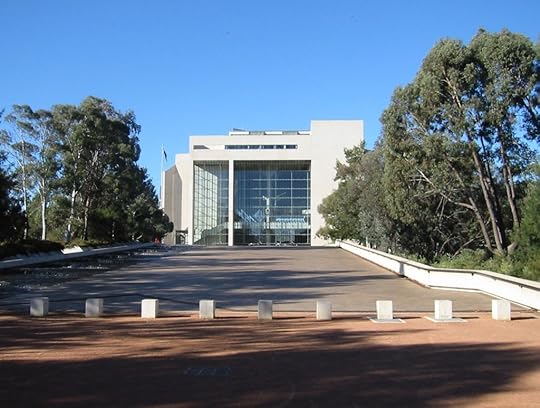
http://cpd.org.au/wp-content/uploads/2016/02/sra_20160207_0935.mp3
The High Court has affirmed the Australian Government’s right to operate offshore detention centres, but the politics remain fraught. The public have reacted with protests around the country chanting the slogan ‘Let Them Stay’ while church leaders are offering sanctuary to asylum seekers who face being sent to offshore detention, potentially risking 10 years’ in jail. So what should the government do?
And Here Come The Habibs is a new Australian television comedy show that’s generating online outrage. Featuring the story of an Australian-Lebanese family, the program has been accused of casual racism.
Guests
Travers McLeod: CEO, Centre for Policy Development
Esther Anatolitis: Director, Regional Arts Victoria
Stephen Brook: Editor, The Australian
Credits
Producer: Jonathan Green
Producer: Serpil Senelmis

The post Outsiders: boats and babies and Here Come The Habibs appeared first on CPD.
We must not give up on Syrian peace talks
This piece was originally published by the ABC on 7 February 2016.
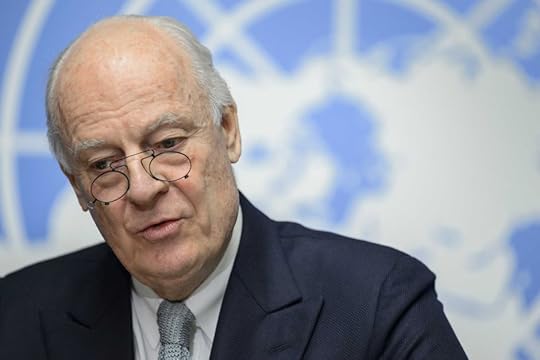
It’s easy to be sceptical of political negotiations about Syria, especially when talks have already been suspended. But with patience and a herculean effort, peace is possible, writes Jeni Whalan.
It only took two days. After a faltering start, the United Nation’s chief negotiator has suspended talks aiming to end Syria’s five-year war.
Though UN special envoy for Syria, Staffan De Mistura, has stressed that this is just a ‘temporary pause’, the lack of tangible progress amid escalating fighting will be seen by many as further evidence that a negotiated settlement in Syria is an idealistic pipedream.
But the road to a peace deal is always paved with failed negotiations, particularly when it must traverse terrain as dangerous as the Syrian war.
The inevitable setbacks that will plague mediation efforts must be met by redoubled international efforts to wrest a diplomatic solution from a conflict that has killed more than 250,000 people, forced more than half the population to flee their homes, and left 13.5 million people in Syria in dire need of humanitarian assistance.
No one expected a breakthrough peace deal this week – not the UN mediator ( operating under the spectre of two previous rounds of failed Geneva talks), not the US, not Russia, nor the regional heavyweights variously aligned with opposing sides of the conflict, not the Assad regime (currently laying siege to 15 Syrian cities and denying a ravaged civilian population urgently needed supplies), and not the fragmented opposition factions (under new pressure from Russian airstrikes and severed supply-lines).
No one even expected the warring parties to sit in the same room, let alone talk directly. Representatives of both the Assad regime and the Syrian opposition had declared their unwillingness to actually negotiate, even via the ‘proximity talks’ model (in which the UN team shuttles between the parties).
While we must never take our eye off the end goal, just getting to the negotiating table – or even to separate rooms in Geneva – is significant.
Simply getting the key Syrian players to agree to turn up at all can rightly be hailed a victory by the negotiating team.
With prospects so bleak, it is easy to be a critic. The three-week pause in negotiations is unlikely to alter the overwhelmingly pessimistic predictions; the talks will come to nothing, they will give the warring parties time and new cause to escalate fighting, and they will strengthen the Islamic State.
Yes, these talks have failed to provide any tangible relief from the scale of human suffering in Syria and a ceasefire deal is a long way off. But that’s how peace talks work: slowly, erratically, and usually thanks only to politically serendipitous conditions that have little to do with the civil war itself.
Take the Bosnian war. There too, negotiators attempted to forge peace amid intense fighting, unspeakable atrocities committed by thugs who would eventually be convicted of war crimes, devastating urban sieges, and a massive outpouring of refugees.
The Bosnian war was eventually settled under the Dayton Peace Agreement, frequently invoked as a model for Syria, but only after the failure of 30 mediation attempts and ten negotiated agreements.
Negotiating peace in Syria is a far more difficult prospect. Not since Cambodia has a civil war attracted such focused diplomacy from outside players with such divergent interests. It took a decade of international attention, 15 distinct mediation attempts, and the end of the Cold War before a comprehensive Cambodian peace deal was finally signed in 1991 – including by the genocidal Khmer Rouge.
Lebanon’s second civil war saw 28 mediated ceasefires before a comprehensive peace agreement was signed in 1989.
Convincing bitter enemies to lay down their arms and agree the terms of lasting peace is among the most difficult tasks of international affairs.
Sierra Leone’s conflict ended only after mediation attempts by 55 different negotiating teams.
While we must never take our eye off the end goal, just getting to the negotiating table – or even to separate rooms in Geneva – is significant.
Inconclusive mediation now can still lay essential foundations for a concrete settlement later. Talks allow warring parties to gather new information, reconsider their views of the enemy, and identify potential areas of common ground that can’t be gleaned from battlefield tactics.
Negotiations let parties articulate their case to one another, to their constituents, and to the world at large. Talks have already pushed the disparate Syrian opposition groups to formulate a common position, to negotiate among themselves, and maybe even to develop a united front.
Talking about talks is, in other words, a crucial part of any peace process. For mediators, talks increase their familiarity with the warring parties, making more transparent the political dynamics within each faction and possibly identifying moderate blocs more favourable to negotiation.
Convincing bitter enemies to lay down their arms and agree the terms of lasting peace is among the most difficult tasks of international affairs.
In Syria, it will require a herculean effort. A decisive breakthrough will probably be the result of dynamics far from the devastation of Homs, Aleppo, and Damascus.
But negotiators – and those committed to eventual peace in Syria – must be ready to seize that window of opportunity when it eventually appears.
Dr Jeni Whalan is a Senior Lecturer in Peace and Conflict Studies at the University of Queensland, and serves on the board of the Centre for Policy Development.

The post We must not give up on Syrian peace talks appeared first on CPD.
January 18, 2016
CPD’s top speeches of 2015
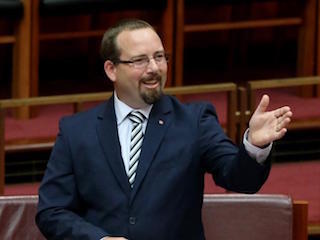
Senator Muir surprised everyone with his election, then again with his moving maiden speech to Parliament. He was one of several Australians who gave powerful speeches in 2015. Photo source News Corp Australia article March 5 2015, photographer Ray Strange.
2015 was an extraordinary year in Australian politics. We saw our fifth Prime Minister installed in five years, pointing to a deep policy malaise currently at the heart of our democracy. It seems governing in the national interest is getting more and more difficult and our long term needs remain largely unaddressed.
Amidst the partisanship doom and gloom, Parliament continues to be served by some of the country’s brightest citizens. In the community, extraordinary men and women rouse national attention and ignite passion on key long-term issues.
Last year has seen a number of these people deliver powerful speeches that expertly capture the importance of key policy challenges that are still outstanding.
We have picked out what we think are the best speeches delivered by our elected parliamentarians and community figures, as a way to remind us that we have capable and inspiring leaders in our midst who can deliver rousing, passionate oratory urging us to do better as a country.
CPD presents the top speeches delivered in 2015
They were not cowed: Prime Minister Turnbull on the Paris terrorist attacks , November 2015
Australians settled in for their Saturday morning only to be confounded and horrified by the bloodshed in Paris’ streets. The Prime Minister, in Germany, received briefings throughout the night and soon returned to Australia, where he addressed the Parliament. He promised that the harmony of Australia’s multicultural society offered one of our strongest lines of defence against the scourge of terrorism.
My Uncle Derek: Tim Watts, Federal Member for Gellibrand, speaks on marriage equality , August 2015
It started as a response to earlier remarks made by Senator Abetz on the subject. However, in one of the Parliament’s modestly attended committee rooms, Tim Watts delivers an emotional and personal account of the experiences of his Uncle Derek, and the abuse and torment he faced as a gay Australian in the 1980s and 1990s. In only 4 minutes, Tim Watts delivers a passionate case about why Australia must introduce marriage equality in Australia by sharing his family’s story.
Revitalising the Republic: Peter FitzSimons on the need for an Australian head of state , August 2015
The new chair of the Australian Republican Movement Peter FitzSimons is a larger-than-life personality, and in a short period of time has infused a renewed sense of urgency and vigour into the Republican cause. The ARM has experienced a surge in membership, including public declarations of support from parliamentarians and community figures alike. He took to the podium at the National Press Club to deliver a rousing address about contemporary Australia and to clearly articulate why an Australian head of state is a necessity, not a luxury.
Australia, freedom and the law: Gillian Triggs provides high oratory to the Human Rights Dinner , June 2015
John Kennedy defined courage as ‘grace under pressure’. Undoubtedly, Gillian Triggs has demonstrated this virtue in her role as President of the Human Rights Commission in 2015. Nothing epitomised her courage more than her speech at the Human Rights Dinner, which came at a period when there were relentless assaults on the independence of her role. Gillian Triggs deftly reasoned why the principles espoused in the 800 year-old Magna Carta are so vital to contemporary Australia. During this speech she also identified alarming breaches of our liberty undertaken in recent times via laws on arbitrary and indefinite detention, and counter-terrorism.
The surprise senator: Ricky Muir delivers his maiden speech, March 2015
Ricky Muir’s election to the Senate surprised everyone, including those who voted for him. However Ricky Muir has taken to his task by being judicious, deliberate and thoughtful, scrutinising legislation on its merit. In delivering his maiden speech, at times nervously, he highlights a fresh approach to the usual business of the political class and a deep sense of duty he feels to his Victorian constituency. He outlined his family’s modest background, his personal struggles with unemployment and his singular reliance on his family’s love and compassion.
Valuable persons still: Tanya Plibersek, Deputy Opposition Leader and Member for Sydney, speaks on the death penalty , February 2015
More than 250 Australians are in prisons overseas at any one time with some of those facing the death penalty. Both sides of parliament share an anguish in deciding how to handle Australians sentenced to death overseas whilst respecting the sovereign law of foreign nations. During a rare demonstration of collective sorrow and empathy between the Government and the Opposition, Tanya Plibersek advocates against the death penalty by sharing her husband’s story with members of the house. Tanya Plibersek perfectly captured the cruelty and futility of the death penalty, and provided an important example of the potential of people to rehabilitate and become upstanding citizens of society.

The post CPD’s top speeches of 2015 appeared first on CPD.
January 17, 2016
Battle of ideas is on as election-year innovation debate starts to make up for lost time
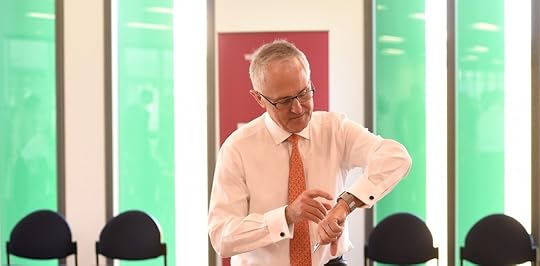
We’re now in a race to the top on innovation. Better late than never.
Liberating ideas could reboot Australia’s economy, as we argued a year ago.
Now it seems there are more ideas about how to generate ideas than ever before in Australian policymaking. Both the Liberal-National government (“Welcome to the Ideas Boom” and the National Innovation and Science Agenda) and Labor opposition (“Powering Innovation” and “Getting Australia Started”) have put down markers around innovation in the lead-up to this year’s federal election.
The Coalition and Labor pronouncements have much in common:
growing awareness that our innovation future lies beyond national boundaries – for example, “launching” and “landing pads” linked to innovation hubs abroad, connecting the Aussie diaspora overseas, and new visas for entrepreneurs;
support for science, technology, engineering and mathematics (STEM) studies, which includes reducing gender disparities;
facilitating access to finance for start-ups and innovative enterprises through tax breaks and the like;
enhancing digital capabilities, which includes teaching kids to code;
fostering greater collaboration, especially between industry and research bodies;
new bodies to oversee innovation, science and technology: Innovate Australia (Labor) and Innovation and Science Australia (Coalition); and
action on government procurement.
A common goal, but key policy differences
Yet within this apparent new spirit of bipartisanship are some key differences. Some are subtle, others are not so. That is before one starts haggling over whose purse is bigger than the other’s.
The Turnbull government’s package is pitched further down the value chain, notwithstanding measures to promote STEM studies. It presumes a core capability in the economy: the assumption is that what’s missing is the key to unlock and leverage this capability. Coalition policy includes, for example, reforming Australian Research Council linkage projects and connecting industry to innovation infrastructure.
Labor seeks to build foundational capabilities from the ground up. It puts more emphasis on teaching computer coding in schools, preparing small to medium-sized enterprises to access government procurement, developing a national digital workforce plan and incentives for graduates to start businesses.
Interestingly, in a political role reversal, the Coalition’s plan has more of a selective orientation by technology and institution. This is reflected in the Biomedical Translation Fund, the Cyber-security Growth Centre and the CSIRO Innovation Fund.
Labor is more about generic capabilities across the board. This distinction, however, is not black and white.
Labor emphasises the innovation ecosystems view of the world. It plans to create regional hubs, with university-based accelerators at the core of this approach, and a national entrepreneurship support network. It speaks of an Innovation Investment Partnership to bring together venture capital, superannuation funds and start-up stakeholders to promote new business.
A distinguishing feature of the government’s package is its emphasis on an innovation culture. Reforming insolvency laws to reduce the stigma of failure is its centrepiece.
Also noteworthy is a revised approach to measuring research impact. That includes engagement with industry metrics. This is in the spirit of breaking out of research silos.
Both parties have a “challenges program”.
The Coalition has nominated five national policy and service delivery challenges. Businesses are invited to submit proposals to address them, with winning ideas to receive grants. The most successful could be accelerated to prototype or proof of concept.
Labor’s approach is more grassroots-oriented, like in the US. It proposes a portal for government agencies to propose challenges for the public to respond to.
What more can be done?
There is strength in diversity and much to commend in both plans. Yet more could be done in the following areas:
explicitly linking domestic challenges to corresponding global problems, thereby positioning Australia as a “solutions hub” and a leader in scaleable open-source projects and the internationalisation of ideas;
promoting community-driven innovation – greater intergovernmental co-ordination could scale up local solutions to local problems to a regional or national level where appropriate;
stronger emphasis on spreading knowledge through the economy, with university “impact” measurement expanded beyond excessive reliance on books and journals, or even commercialisation;
a “beyond STEM” approach to innovation, recognising the interdependencies of scientific research and non-research forms of innovation such as design and organisational systems, together with the social sciences’ pivotal role in driving prosperity within innovation ecosystems;
defining a stronger role for particular agents and locations – not least cities, women and girls – in the process and outcomes of innovation; and
a stronger ”lifecycle” view of innovation and entrepreneurship, going beyond the traditional emphasis on start-ups to include later growth stages in a seamless approach to innovation and wealth creation.
We need a transforming, global vision
Finally, to be credible, innovation policymaking must be located within a long-term vision of the structure of the Australian economy we should aspire to. It also demands honesty about the scale of the transformation required.
So the glass is half-full and rising. There are international precedents more like pints than pots.
China’s innovation hub, Chengdu, has partnered with European Union companies and organisations to share innovations among small and medium businesses and universities. The US has launched next-generation manufacturing hubs. Even one of the world’s oldest universities, Oxford, wants to be more agile in developing and translating ideas conceived in the dreaming spires.
Ideas have started to travel the world over. Australia has barely reached base camp in the race to the top.
Still, it’s encouraging to see Australian policy proposals breaking free of archaic and stifling debates about protectionism and picking winners. The world of ideas knows no boundaries.
This article was originally published in The Conversation on the 18 January 2016. Photo courtesy of AAP/Dan Himbrechts.

The post Battle of ideas is on as election-year innovation debate starts to make up for lost time appeared first on CPD.
December 15, 2015
Travers McLeod: Genuine ‘excitement’ requires gifted policy
‘Tis the season to be jolly, as they say.
Or, excited, as Prime Minister Malcolm Turnbull repeats on cue, like a Santa Claus ‘Ho-Ho-Hoing’ through the local shops.
His change of tone since ending Tony Abbott’s Prime Ministerial reign is a relief. Turnbull’s optimism is a breath of fresh air after years of Abbott’s negative focus on what the future won’t include, as opposed to what it might.
Converting this excitement into gifted policy is a greater challenge.
It is an exciting time to be an Australian.
We’ve had nearly a quarter century of uninterrupted growth. Several of our cities are among the world’s most liveable. Workers benefit from hard-won protections and a minimum wage. Communities boast high levels of cohesion and are among the most multicultural on Earth. And our health and education systems are envied the world over.
This year the Huffington Post declared Australia a ‘stunningly perfect place to travel’. We’re lucky we don’t have to travel anywhere for perfection!
Yet such excitement risks being rose-tinted.
Wage growth in Australia is the lowest since records began. Long-term unemployment is the highest in nearly two decades. More than a quarter of Australians in prison are Aboriginal and Torres Strait Islander. They are descendants of the original Australians, about whom our Constitution is still silent.
We continue to lock up children fleeing persecution. We’ve agreed a goal to limit temperature rises to 1.5 degrees, yet we’re ranked third-last in the Climate Change Performance Index. And Australians of Islamic faith are wrongly lumped together and told to shape up or ship out almost daily.
One’s excitement about being an Australian shouldn’t be contingent on their postcode or religion. We’re better than that.
To get into the festive spirit this December, the Centre for Policy Development asked some distinguished Aussies to be ‘Secret Santas’ for their country.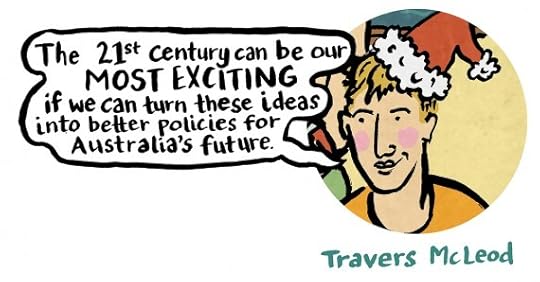
Each offered a ‘gift’ of fresh thinking on an issue close to their heart. There were seven brilliant women: Queensland Young Australian of the Year, Yassmin Abdel-Magied; philanthropist and businesswoman, Janet Holmes à Court; Lord Mayor of Sydney, Clover Moore; Australian human rights lawyer, Jen Robinson; CEO of Amaze (Autism Victoria), Fiona Sharkie; and CEO of Oxfam Australia, Helen Szoke.
Several men were the support acts: University of Melbourne Vice Chancellor, Glyn Davis; former President of the Royal Society, Bob May; recent Australian of the Year, Pat McGorry; and CEO of the Northern Agricultural Catchments Council, Richard McLellan.
Together, they gifted us a thought-provoking summer reading pack.
They asked us to consider how exciting the next few decades could be.
Imagine, for a moment, being abroad in 2030. You’re asked about your sunburnt country, Australia, and proudly describe a place where:
Culturally and linguistly diverse young Australians all feel they belong;
Teachers get students to think for themselves and ask difficult questions about Australia’s place in the world;
Gender equality isn’t an aspiration, it’s a given;
Farmers, supply chains and markets reinforce a virtuous cycle of productive, profitable and sustainable produce;
Original Australians, and their descendants, are truly recognised;
Universities have a knowledge footprint revealed by better social outcomes across society at large;
Australians with a disability flourish at work and in the community;
Art and culture is healthily funded, showcasing the essence of Australia;
Your rights, like being able to marry your beloved or not being arbitrarily detained, are protected by a Bill of Rights;
Cities are bastions of decarbonisation, innovation and unity; and
Mental health and wellbeing is valued as much as physical health, and invested in accordingly.
This is a picture worthy of Australia.
This century can be the most exciting one for all Australians provided we turn these ideas into a present for Australia’s future.
To be sure, these are complex and uncertain days. Growth is tepid. Individuals can mobilise terrifying violence in our neighbourhoods. Automation is changing the face of work and, with it, how we forge careers. Inequality grows the world over, not least down the road. And changes to our environment have outpaced our most agile leaders.
Perhaps the most dangerous development, however, has been the impotence of our institutions. Too often recently they have let Australians down, failed to live up to their promise, or renewed themselves to do so.
The transmission belt of ideas into policies and actions has stalled.
This is where independent, values-driven and evidence-based think tanks are important.
Together, we need to foster an Australia that embraces the long term now.
Policy development should be geared towards an Australia that is equitable, aspirational and truly prosperous – enlivened by the challenge of shaping a better future at home and abroad.
Part of this is fusing domestic and international insights, combining fresh expertise to build a progressive Australian agenda.
Whether it’s on climate security, sustainable agriculture, forced migration or human services – the issues we’ve covered in 2015 – CPD’s model is three-fold.
We create viable ideas from rigorous, cross-disciplinary research here and overseas. We connect experts and stakeholders to develop these ideas into practical policy proposals. We then work to convince government, business and civil society of the merits of implementing these proposals.
Australia needs more Secret Santas like those CPD has introduced this month. We need organisations straddling the spectrum from ‘ideas’ to ‘policies’ too, enlarging our national polity and helping to renew our democracy.
Only then can we translate the excitement of this century into policies that can transform the lives of all Australians.
—
Travers McLeod is CEO of the Centre for Policy Development.
This blog concludes the Secret Santas for Australia series produced by CPD and published by HuffPost Australia.

The post Travers McLeod: Genuine ‘excitement’ requires gifted policy appeared first on CPD.
December 14, 2015
Patrick McGorry: Gifting more resources to transform mental health
Who could argue with the fact that mental health is the awakening giant of modern health care?
Awareness is at an all time high and tolerance and stigma have improved dramatically over the past decade. The individual and collective costs of mental ill health are better understood. An array of economic experts, including our own Professor Alan Fels, have confirmed mental illness is the greatest threat among the non-communicable diseases to the Australian and global economies over the next 20 years.
Despite this, mental health care remains relatively flimsy and rationed in a way that physical health care is not. Under-investment has resulted in poor access and coverage. A mere 40 percent of Australians with a genuine need for care receive access to any level of care. Only 11 percent get minimally adequate evidence-based care. Imagine the outcry if only 11 percent of people with breast cancer were accessing evidence-based care.
Cancer care is a perfect benchmark for mental health care. In cancer, we practise prevention wherever possible. We place a huge premium on early diagnosis. Once diagnosed, the full complement of evidence-based treatment is guaranteed and deployed. If sixteen courses of chemotherapy are required to give the best chance of remission, they are provided. Patients are not short-changed. If expensive new cancer drugs are discovered, the government rapidly subsidises them. Patients retain secure tenure in specialist care from initial diagnosis for as long as required. Innovation and research are part of the fabric of cancer care.
Redesigning and resourcing mental health care to deliver all these features would will save lives, transform futures and save billions. But there remains a huge disconnect between the major advances in public awareness and expectation of mental health and the unacceptably poor levels of access, quality and tenure in mental health care.
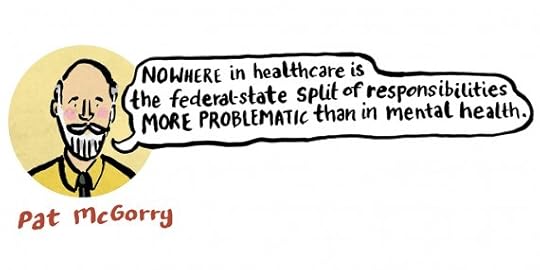
Governments are understandably concerned about exponential growth in health care costs. Investing preferentially in health care is a key part of the solution. We spend just $7.6 billion on direct mental health care, of around $140 billion on the whole health system. This serious under-investment locks many people out of timely evidence-based care.
Investing more dollars in direct mental health care, uniquely in the health system, will result in massive savings across government expenditure. Today’s under-investment creates huge downstream costs — at least $20 billion per annum, including though disability support payments, to people whose lives would have been more fulfilling and contributing had they received expert help earlier. This chronic public policy failure results in an all-too-silent wave of 50 preventable suicides every week, and a vast hidden burden of suffering, disability and premature death through other non-communicable diseases.
Redesign of the mental health system is certainly a key first step, one the government took in November in its long-awaited response to the National Mental Health Commission’s report. The general thrust of this redesign is positive. It contains many features which, for example, made headspace such a success: a devolved model based around enhanced primary platforms, early intervention, stepped care and embedding and streamlining new technologies to support face to face care.
The Federal Government has reimagined the front end of a new vehicle, but it won’t reach its destination unless the whole car is designed and built, complete with more petrol in the tank and a roadmap for where we want to go. This map must safeguard and prioritize evidence-based programs, and a focus on young people and those in the prime productive years of life. These are already working well and can be improved and adapted to other life stages.
Nowhere in health care is the Federal-State split of responsibilities more problematic than in mental health. Care is provided for shorter and shorter periods of tenure within cash-strapped State-funded services for only some of the people with acute episodes of severe and enduring mental illnesses and others in life-threatening circumstances. This system of last resort is a terribly disappointing successor to the old asylums.
Care is also available for milder forms of common mental disorders through Federally-funded, capped programs such as Better Access. But the “missing middle” — hundreds of thousands of Australians with moderately complex or persistent disorders — have nowhere to go. Private psychiatry is financially out of reach for many ordinary people, and often not fit for purpose anyway, lacking flexibility and case-management capacity.
The Federal Government has recognized this problem and rightly seeks to add new expertise and capacity from the primary care end. But solving it requires substantial growth in investment federally, from the States, or both. Instead, weak revenues mean there will likely be a retreat on either side of the divide, threatening hard-won progress — especially in youth mental health innovation.
The new positive tone federally and in several State governments gives us hope that innovation and reform are within our grasp. But we must ensure the awakening giant of mental health is not allowed to tamely doze off again.
Last week Australians for Mental Health, a grassroots organization to give a voice to the 4 million Australians affected by mental ill health every year, held a major launch event in Melbourne to give its verdict on the state of mental health care in Australia. This national voice needs to become much stronger and clearer in its ideas and transformative solutions as we enter another election year in which mental health care must be a dominant focus once again.
If you need help in a crisis, call Lifeline on 131114. For further information about depression, contact beyond blue on 1300224636 or talk to your GP, local health professional or someone you trust.
—
Patrick McGorry is the Executive Director of Orygen (the National Centre of Excellence in Youth Mental Health) and Australian of the Year in 2010.
This is the 11th piece in CPD’s ‘Secret Santas for Australia’ series. Each day we will reveal one ‘gift’ of good ideas from a prominent Australian on a policy issue close to their heart. You can see the full set here.

The post Patrick McGorry: Gifting more resources to transform mental health appeared first on CPD.
December 13, 2015
Clover Moore: Resilient cities will be critical gifts for Australia’s future
By global comparisons, Sydney is a fortunate and equitable place even though we are grappling with the impacts of climate change and cyber-attacks, lack of affordable housing and traffic congestion.
Last week, as part of the UN climate talks in Paris, I spoke with Mayors from Rotterdam, Santiago and Addis Ababa about our efforts to jumpstart resilience in cities. How we respond to shocks like the Lindt siege is heavily dependent on how resilient we are as a city. And to manage the impact of future shocks, we’re going to have to invest now to build the capacity so it’s there when we need it.
Together with the Rockefeller Foundation’s 100 Resilient Cities program, we’ve recruited a Chief Resilience Officer for Sydney. Beck Dawson, our first ever CRO, has a far wider remit than simply the City of Sydney.
To build the kind of city-wide resilience we need means working across multiple layers of government, and planning the resources, policies and budget needed to manage future stresses and shocks.
Like other cities around the world, we’re experiencing increasing cyber-attacks — last year attacks on business and government increased by 20 percent. And the events of a year ago, when 18 people were held hostage for 16 hours in a café in Martin Place, and three people lost their lives — including the lone gunman who had a mental illness, a violent history and should not have been out on bail — was a traumatic experience for Sydney.
Police, paramedics and emergency services did an inspiring job during that trying time, with multiple levels of government working together under tightly practiced protocols.
The very real risk that the siege might set off a chain reaction of tit-for-tat attacks on Muslim Australians, fanned by tabloid columnists, was quickly dampened by our multicultural, harmonious society.
Our many communities came together in an outpouring of grief and solidarity, quickly coming up with #IllRideWithYou — a Twitter hashtag that linked people who wanted to stand (or in this case, travel) with their Muslim neighbours.
Two decades of sustained population growth has made our city the most densely populated in Australia, but we face declining housing affordability, rising inequality, growing homelessness and lone-person households at risk of social isolation. This crisis in housing affordability can only be solved with all of government and the construction sector working together.
We have worked to increase the supply of affordable housing for people on lower incomes — over 1300 homes have either been built or are in the pipeline and Council is now finalising a housing issues paper that identifies options for action.
Since 2004, we’ve completed over 250 major projects including parks, playgrounds, childcare, pools, libraries, theatres, community and cultural spaces. We’re now working on 370 projects as part of our 10-year capital works plan. These projects provide the spaces where people naturally meet, build relationships and become communities.
Sydney does well in global city rankings, but is constantly marked down for poor transport — a responsibility of our State Government. Congestion currently costs Sydney around $5 billion each year and that is projected to double by 2021 with a rapidly growing population.
We did our own research with the best minds in transport and city design, including renowned urbanist Jan Gehl, to develop a transport policy. Now most of our transport policies such as light rail, a bike network and pedestrianisation are reflected in the current Government’s own plan.
All these issues that demand resilience in our cities will be exacerbated by climate change, and the extremes of weather are accelerating.
Increasing heat is considered the most chronic issue, which in 2009 became an acute risk. After an intense drought and weeks of oppressive heat, the worst bushfire in Australia’s history killed 173 people, injured 5000 and destroyed over 2000 homes. As tragic as that day was, more people died from the heat in the weeks leading up to the bushfire than in the bushfire itself.
The smoke and ash produced by rampant bushfires is a threat, with air pollution directly affecting the people who live, work and visit the city. Extremely heavy rain is expected to remain a feature of Sydney’s weather patterns and become increasingly common. Rising sea levels are considered a minor threat in the short term – even so, waterfront developers are already assessing this risk and new developments have been raised in response.
Waiting for the worsening effects of climate change to eventuate is not an option.
We have invested heavily in reducing the carbon emissions causing climate change, setting an ambitious target to reduce emissions by 70 percent by 2030 (on 2006 levels). And our early resilience planning has set out priorities that the City will now act on, such as developing a heatwave response plan, raising awareness about climate-related events such as air pollution, bushfires and heatwaves and developing a sea level rise adaption action plan.
Other work in the pipeline includes working with energy companies to assess trigger points and potential vulnerability of the City’s power supply, and calling for changes to engineering and building standards and codes to address climate change.
We know building resilience on an urban scale means we must all work together — it’s not something that any one organisation or indeed one level of government can do.
By sharing information about key threats and tools for addressing those threats we can take a practical, cooperative approach. That will help us minimise the impacts of chronic stresses and deal with shocks when they come.
_______________
—
Clover Moore is the Lord Mayor of the City of Sydney.
This is the 10th piece in CPD’s ‘Secret Santas for Australia’ series. Each day we will reveal one ‘gift’ of good ideas from a prominent Australian on a policy issue close to their heart. You can see the full set here.

The post Clover Moore: Resilient cities will be critical gifts for Australia’s future appeared first on CPD.
December 10, 2015
Deepening Australia’s regional relationships through climate security
This article was originally published on The Strategist for the Australian Strategic Policy Institute (ASPI) on 3 December 2015
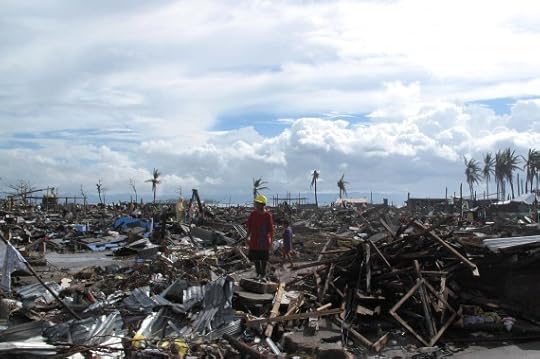
In The Longest Conflict: Australia’s Climate Security Challenge, I argued Australia’s ‘longest conflict’ this century would be the struggle to address our climate vulnerabilities at home and abroad. Our national security approach to a changing climate remains significantly underdeveloped and under-appreciated by our political leaders. When retired UK Rear Admiral Neil Morisetti launched the Centre for Policy Development’s report in June this year, he declared any national security strategy failing to deal with a changing climate was a flawed strategy. Prime Minister Turnbull, Defence Minister Payne and the National Security Committee must heed this warning in revising the Defence White Paper. The Federal Government has the chance to address climate security far more seriously and in doing so develop a credible and shrewd long-term strategy. This strategy should identify not just climatic threats but also opportunities for Australia to strengthen and deepen its ties within the Indo–Pacific through action on climate security.
Climate change undermines regional human security, with inaction breeding greater insecurity. Conventional wisdom about Australia’s geography is that we are uniquely located to capitalise on the unfolding economic expansion in East Asia. However, missing from this assessment is an understanding of the climate security challenges confronting our region—which is the most vulnerable in the world to a changing climate. We are situated at the frontline of emerging climate crises that threaten long-term destabilisation in the Indo–Pacific. Asia is a precarious mix of dense urbanisation, low-lying coastal areas, rapacious resource demand and catastrophic natural disasters.
Seven out of ten of the world’s most vulnerable countries to climate change are in the Asia–Pacific. Asia has approximately 90% of the world’s risk of tropical cyclones. On a conservative estimate, by 2030 about 880 million people will live in low coastal zones vulnerable to storm surges and sea-level rises, with 70% of these living in Asia. Tensions caused by increasingly scarce food, energy and water will be exacerbated by climate change in a region already adjusting to a more fluid and contested geopolitical order. Emerging superpowers will be jostling for security alongside developing nations with fragile economies and equally fragile governments. The Middle East is a perfect example of how climate change can act as a threat multiplier in fostering political instability.
Australia has a constructive and positive role to play in collaborating with our partners and neighbours in building climate resilience and improving regional human security. We can strengthen both our hard and soft power with the right approach. The US and UK are the prime examples of major powers actively addressing climate security at the strategic and operational level. The UK’s latest National Security Strategy and Strategic Defence and Security Review released in November explicitly outlines how it could use climate change constructively to extend its global influence, including how it can build resilience in particularly vulnerable states. For instance the UK will strengthen its cooperation with ASEAN states particularly regarding humanitarian aid and disaster relief, as well as prioritise climate change in its bilateral relationships with South Korea, India and China. We should follow suit considering how pivotal these countries are to our immediate security interests.
Utilising our meritorious ADF, Australian should offer leadership that encourages regional cooperation on defence preparedness for climate crises. Australia should undertake climatic risk assessments with allies like Japan and the US, and strategic partners like Indonesia to identify critical regional vulnerabilities and to then develop joint responses. This includes likely humanitarian flashpoints in the region (such as population displacement in Bangladesh or extreme heat fatalities and power outages in India and Pakistan) exacerbated by climate change as well as mapping present and future resource insecurities. Equally important is improving cooperation with regional neighbours, especially ASEAN members, to ensure effective responses at times of crises. Executing effective joint-responses to humanitarian and natural disasters will be pivotal in coming years. Similarly, war-gaming scenarios should be undertaken that plan for climate security challenges such as energy shortages, natural disasters or climate-induced population displacement. Rim of the Pacific Exercises (RIMPAC) for instance offer a valuable array of partners with which to undertake such activity. In discussions with CPD throughout 2015, senior ADF officials demonstrated a willingness to tackle the big climate security challenges proactively. This requires concerted political leadership from the Government.
Further, Australia should work with neighbouring countries to invest in and improve their climate adaptation capacity, in particular the resilience of vulnerable communities. Prime Minister Turnbull flagged this at COP21, but much more can be done. A recent global study by Portland Communications ranked Australia 6th in the world on soft power. We could better utilise our soft power reserves in order to address climate change more aggressively. A strong and well-financed aid and development program that invests in local climate adaptation and mitigation programs in the region will improve the capability of our neighbours to prepare for the future and enhance human security in a changing climate. Additionally Australia should look to boost regional climate literacy and adaptation expertise by harnessing our other soft power assets like commercial expertise in primary resource management, urban design, early technology adoption and innovation, or our world class international education services and exchange programs. Such international contributions will strongly signal our commitment to a peaceful, orderly and prosperous Indo–Pacific.
The latest indications from the IPCC are that climatic impacts are actually accelerating beyond current estimates. By Christmas, the world passes the 1 degree Celsius temperature increase, half way towards the scientifically accepted threshold of 2 degrees Celsius by end of the century. The UN confirmed in November that 2015 has been the hottest year on record, with 2011–15 the hottest five-year period. Accelerated temperature shifts only increase the human security impacts felt by our neighbours and partners. It would be short-sighted not to infuse our foreign and security policies with a long-term strategy for tackling this profound security issue and would represent another lost opportunity to deepen and broaden our regional relationships in the Asian Century.
Photo from UK Department for International Development courtesy of Flickr

The post Deepening Australia’s regional relationships through climate security appeared first on CPD.
Centre for Policy Development's Blog
- Centre for Policy Development's profile
- 1 follower



